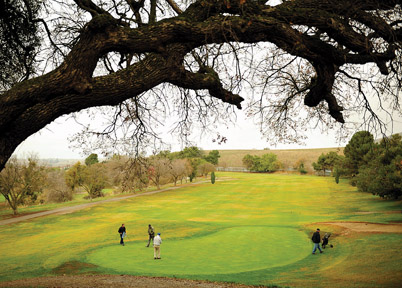
Club officials say boost needed, or closure possible
Officials running the Bolado Park Golf Course, which has faced
financial difficulties for about a decade, have a message about the
future of the county’s oldest spot to shoot a round: The 9-hole
course isn’t scheduled to close, but it needs a big boost or could
face its demise sometime soon.
”
Put it this way,
”
said Steve Janisch, the PGA general manager who joined Bolado
two years ago, and helped to open other area courses such as San
Juan Oaks and Eagle Ridge in Gilroy.
”
There’s a pulse, but it’s kind of a weak one. We’re trying
everything we can. Right now, it is literally a month-to-month
situation here.
”
Club officials say boost needed, or closure possible
Officials running the Bolado Park Golf Course, which has faced financial difficulties for about a decade, have a message about the future of the county’s oldest spot to shoot a round: The 9-hole course isn’t scheduled to close, but it needs a big boost or could face its demise sometime soon.
“Put it this way,” said Steve Janisch, the PGA general manager who joined Bolado two years ago, and helped to open other area courses such as San Juan Oaks and Eagle Ridge in Gilroy. “There’s a pulse, but it’s kind of a weak one. We’re trying everything we can. Right now, it is literally a month-to-month situation here.”
Bolado Park Golf Course officials, after years of plummeting revenues, are realistic about the possibility that it can’t continue down its current path – which has seemed almost irreversible at times and has been further steepened by the recession. Something has to give: Sometime soon they’ll have to see increased business, major charitable backing or additional leeway in a lease with the state at a price tag of $25,000 annually.
It has been an increasingly rough situation for the course built in 1946, on land deeded to the state in perpetuity with a guarantee it remains used for recreational purposes. But since 2000, Janisch estimated, Bolado Park Golf Course has operated at a deficit.
One of the bigger contributors at the property owned by the 33rd Agricultural District has been an aging population. Membership has dropped from around 300 in the late 1990s to about 150 to 160 today, Janisch said. In recent times, membership has taken a 20 percent to 25 percent hit annually, he said. But other deterring factors have included added competition, with San Juan Oaks Golf Club built in 1996 and Ridgemark Golf & Country Club expanding its hole offerings.
Bolado Park simply hasn’t had the resources to keep pace, as the grounds’ quality declined through the years, particularly the cart paths, bunkers and irrigation system. The club generally can’t afford anything beyond basic maintenance, Janisch said, noting how the course has a three-person grounds crew, while others usually have four to six and upwards.
He and board member Phyllis Swallow, who both interviewed with the Pinnacle this week at the Bolado clubhouse, believe those conditions have compounded the declines seen in membership and daily play by the public. And they also contend that the lease amount with the state – the original amount was $1 per year – has strapped the club financially and led to less-than-adequate upkeep.
Janisch acknowledged that “a lease is a lease” but went on: “I believe the (Bolado Park Golf Course) board has spoken with them down there at the agriculture district to try to sit down and renegotiate.”
Without a change in the revenue and cost trends, Janisch said the state might have to “make a decision” on further action, such as deciding whether the ag district wants to run the property.
In terms of the holiday season, he said, “It would be a great present if that agreement right now could be sat down and talked about, to get the golf course through a rough point.”
Bolado Park Fair Manager Kelley Ferreira, though, noted how the golf course’s board members had approached the district in October to eliminate a stipulation in the lease that called for the state to get a percentage of gross revenues at the course, such as for merchandise.
In terms of reducing the lease amount, though?
“We’re a state agency,” he said. “That’s state property. We can’t just give it away.”
Janisch and Swallow did note how Bolado’s management is trying varying strategies to increase play and revenue there. She mentioned the new “Club 500” program that offers new members unlimited rounds for $500 their first year. Janisch said they raised dues and greens fees a bit because, as he put it, they were “too low for too long” and hadn’t been escalated incrementally. He said Bolado has been proactive with its marketing in general, using such platforms as e-mail for promotion.
If anything, club officials hope there might be a donor or donors in the community who step forward and help.
“We don’t have a scenario over here of having somebody with deep pockets,” Janisch said.









